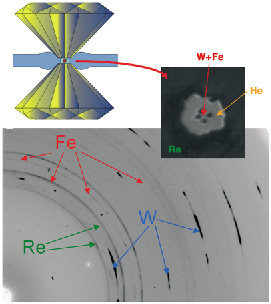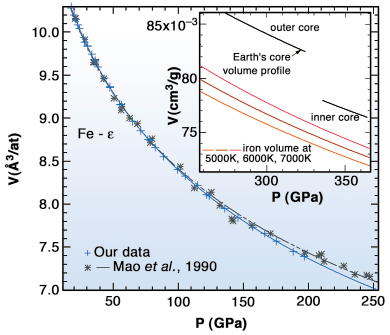- Home
- Users & Science
- Scientific Documentation
- ESRF Highlights
- ESRF Highlights 2006
- Materials Science
- Quasi-hydrostatic equation of state of iron above 2 Mbar
Quasi-hydrostatic equation of state of iron above 2 Mbar
Iron is the major component of the Earth’s core, alloyed with a few percent of nickel and lighter elements [1]. The thermodynamic conditions in this envelope are extreme: the pressure spans between 136 and 329 GPa in the liquid outer core and between 329 and 364 GPa (~ 3.64 x 106 atm) in the solid inner core, and the temperature is estimated to lie between 5000 and 7000 K. The physical behaviour of iron under these conditions is essential knowledge for our understanding of the deep Earth. In particular, its Equation of State (EoS) P(V,T) (P pressure, V specific volume and T temperature) can be compared to seismological measurements to determine chemical and physical state of the core. Major geophysical issues thus rely directly on the accuracy of the EoS of iron.
 |
|
Fig. 20: Monochromatic diffraction pattern recorded at 190 GPa. Iron (sample), tungsten (pressure gauge), and rhenium (gasket) diffraction signal can be easily distinguished. The high-pressure chamber, filled with helium, containing the sample and the pressure gauge (photograph, the size of the chamber is ~ 20 micrometres) is located between the two diamond anvils, in the hole of a rhenium gasket (top picture). |
The diamond anvil cell is the ideal tool to generate pressures in the range relevant to the Earth’s interior. Combined with synchrotron X-ray diffraction, it has already allowed the measurement of the EoS of iron at 300 K up to 300 GPa, this was almost 20 years ago [2]. In the meantime, high pressure techniques and X-ray generation techniques have improved significantly. We thus decided to reexamine the EoS of iron using state-of-the-art diamond anvil cell techniques. The sample and the pressure gauge, tiny grains of iron and tungsten, were embedded in helium, which is used as a quasi-hydrostatic pressure transmitting medium (Figure 20), in a diamond-anvil cell pressure chamber. The volume V of iron was then measured for increasing pressure steps by X-ray diffraction. The high flux and high focussing of the X-ray beam of the ID27 beamline allowed the collection of the monochromatic X-ray diffracted signal displayed in Figure 20 in less than one minute. The compression curve obtained by this method is plotted on Figure 21. We found that the compression of iron is significantly higher than previously measured [2]. This can be explained by non-hydrostatic pressurising conditions – no pressure transmitting medium was used - and a less accurate pressure metrology in the previous experiments [2].
 |
|
Fig. 21: Ambient temperature compression curve of iron measured on ID27 beamline, compared with the data obtained in 1990. The inset shows the volume of iron deduced from this compression curve in the possible temperature range of the Earth’s core, compared with the volume profile measured by seismology. |
Using these data, we built a P(V,T) EoS for iron, which suggests that the Earth’s inner core is lighter than a mixture of Fe and Ni under the same conditions (Figure 21). This can be explained by the alloying of Fe and Ni with several percent of light elements (Si, S, O). These new data increases the estimated content of light elements in the Earth’s core.
References
[1] J.-P. Poirier, Phys. Earth Planet. Inter., 85, 319-337 (1994).
[2] H.-K. Mao, Y. Wu, L.C. Chen and A.P. Jephcoat, J. Geophys. Res., 95, 21737-21742 (1990).
Principal Publication and Authors
A. Dewaele (a), P. Loubeyre (a), F. Occelli (a), M. Mezouar (b), P.I. Dorogokupets (c) and M. Torrent (a), Phys. Rev. Lett. 97, 215504-215507 (2006).
(a) CEA, Bruyères le Châtel (France)
(b) ESRF
(c) Institute of the Earth’s Crust, Irkutsk (Russia)



